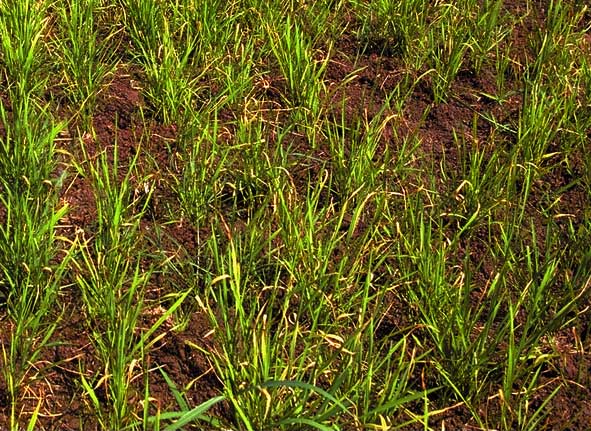Aluminum (Al) toxicity
 What it does
What it does
Aluminum (Al) toxicity in soil inhibits the growth of plant shoots by causing nutrient deficiencies in Magnesium (Mg), Calcium (Ca), and Phosphorus (P).
It can also lead to drought stress and plant hormone imbalance.
Why and where it occurs
Al toxicity is relatively rare in irrigated rice systems.
It rarely occurs in lowland rice except in some soils where there is very slow soil reduction after flooding.
Al toxicity occurs on the following soils:
- acid upland soils (Ultisols, Oxisols) with large exchangeable Al content
Al toxicity often occurs together with Manganese (Mn) toxicity. - acid sulfate soils, particularly when rice is grown as an upland crop for a few weeks before flooding (e.g., Thailand)
- flooded soils with pH <4 before Fe toxicity symptoms appear
How to identify
- Check for leaf discoloration.
- Orange-yellow interveinal chlorosis can be found on leaves.
- When severe, discolored areas can die. Yellow to white mottling of interveins is followed by leaf tip death and leaf margin scorch.
- Also check for poor stunted growth and deformed roots in susceptible varieties.
Why is it important
Al toxicity is one of the major factors in limiting crop production on acid upland soils, and can be a major source of yield loss.
How to manage
To prevent Aluminum toxicity:
- Plant tolerant varieties. Contact your local agriculture office for an up-to-date list of available varieties.
- Delay planting until pH has increased sufficiently after flooding (to immobilize Al).
- Provide crops with sufficient water to maintain reduced soil conditions. Prevent the topsoil from drying out.
- Manage fertilizers efficiently.
- Recycle straw or ash in the field to replenish Silicon (Si) removed.
There is currently no practical treatment option for aluminum toxicity. Where possible:
- Apply 1−3 t lime/ha to raise pH. Determine the exact amount needed based on a lime requirement test.
- Perform laboratory tests and procedures. Ameliorate subsoil acidity to improve root growth below the plow layer by leaching Ca into the subsoil from lime applied to the soil surface. Supply anions SO42- or NO3- to accompany Ca2+ moving into the subsoil by applying gypsum, green manure crop, or urea with additional lime to neutralize the acidity generated in nitrification. Cl- is not an effective counter ion.
- On acid upland soils, install soil erosion traps and incorporate 1 t/ha of reactive rock phosphate to alleviate P deficiency.







